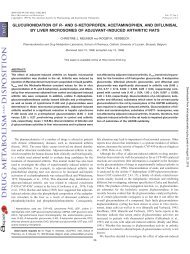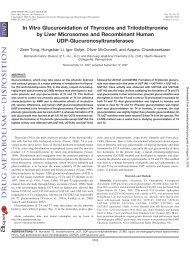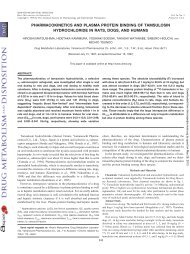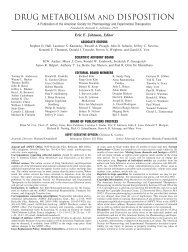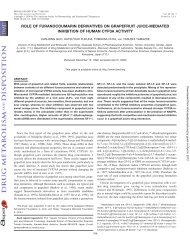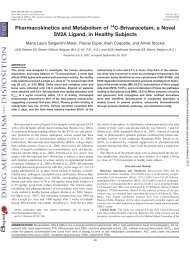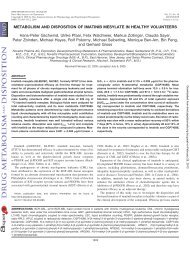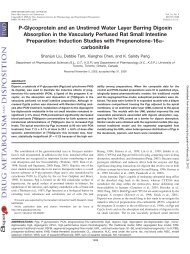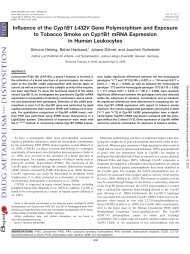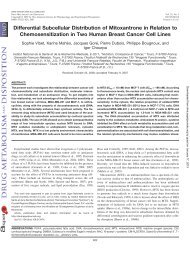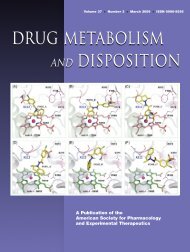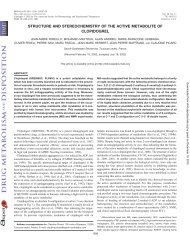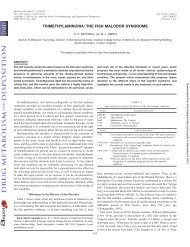development of an in vitro screening model for the biosynthesis of ...
development of an in vitro screening model for the biosynthesis of ...
development of an in vitro screening model for the biosynthesis of ...
Create successful ePaper yourself
Turn your PDF publications into a flip-book with our unique Google optimized e-Paper software.
412 BOLZE ET AL.<br />
FIG. 8.Correlation between <strong>the</strong> extent <strong>of</strong> covalent b<strong>in</strong>d<strong>in</strong>g (prote<strong>in</strong> content normalized <strong>an</strong>d expressed as <strong>the</strong> percentage <strong>of</strong> total acyl glucuronide present at <strong>the</strong><br />
beg<strong>in</strong>n<strong>in</strong>g <strong>of</strong> <strong>the</strong> reactivity phase) versus <strong>the</strong> aglycone appear<strong>an</strong>ce rate const<strong>an</strong>t weighted by <strong>the</strong> percentage <strong>of</strong> isomerization (between biosyn<strong>the</strong>sis <strong>an</strong>d reactivity<br />
phase) (h 1 ) dur<strong>in</strong>g <strong>in</strong> <strong>vitro</strong> <strong>in</strong>cubation <strong>of</strong> various acyl glucuronide with HSA (0.5 mM).<br />
uronide isomers was not a better parameter <strong>for</strong> reactivity prediction<br />
th<strong>an</strong> <strong>the</strong> global acyl glucuronide degradation rate const<strong>an</strong>t described<br />
by Benet. A correlation was also searched <strong>for</strong> between covalent<br />
b<strong>in</strong>d<strong>in</strong>g <strong>an</strong>d <strong>the</strong> hydrolysis rate. The aglycone appear<strong>an</strong>ce rate const<strong>an</strong>t<br />
corresponded to <strong>the</strong> global acyl glucuronide hydrolysis rate. A<br />
satisfactory correlation was obta<strong>in</strong>ed <strong>for</strong> six <strong>of</strong> eight drugs (r 2 , 0.89).<br />
When zomepirac <strong>an</strong>d tolmet<strong>in</strong> were taken <strong>in</strong>to account, <strong>the</strong> correlation<br />
was less satisfactory (r 2 , 0.62) (Fig. 7B). The hydrolysis rate const<strong>an</strong>t<br />
was <strong>the</strong> same <strong>for</strong> both compounds, whereas <strong>the</strong> extent <strong>of</strong> covalent<br />
b<strong>in</strong>d<strong>in</strong>g was higher <strong>for</strong> tolmet<strong>in</strong>. The rate <strong>of</strong> hydrolysis (i.e., <strong>the</strong> rate<br />
<strong>of</strong> aglycone appear<strong>an</strong>ce) does not discrim<strong>in</strong>ate sufficiently to expla<strong>in</strong><br />
<strong>the</strong> reactivity <strong>of</strong> all compounds. For most <strong>of</strong> <strong>the</strong> acyl glucuronides<br />
under study, isomerization was found to occur between <strong>the</strong> first <strong>an</strong>d<br />
<strong>the</strong> second <strong>in</strong>cubation. The extent <strong>of</strong> this phenomenon seemed to be<br />
more or less import<strong>an</strong>t <strong>for</strong> each acyl glucuronide (Table 1). The extent<br />
<strong>of</strong> this isomerization was certa<strong>in</strong>ly related to <strong>the</strong> <strong>in</strong>stability <strong>of</strong> <strong>the</strong><br />
1-O-acyl glucuronide <strong>for</strong>med <strong>an</strong>d its covalent b<strong>in</strong>d<strong>in</strong>g capacity. Indeed,<br />
<strong>the</strong> <strong>for</strong>mation <strong>of</strong> isomeric <strong>for</strong>ms via acyl migration is a prerequisite<br />
<strong>for</strong> covalent b<strong>in</strong>d<strong>in</strong>g to prote<strong>in</strong>s by “im<strong>in</strong>e” mech<strong>an</strong>ism. There<strong>for</strong>e,<br />
<strong>the</strong> aglycone appear<strong>an</strong>ce rate const<strong>an</strong>t was weighted by <strong>the</strong><br />
percentage <strong>of</strong> isomerization between <strong>the</strong> two <strong>in</strong>cubation steps. An<br />
excellent correlation was <strong>the</strong>n obta<strong>in</strong>ed between <strong>the</strong> maximal amount<br />
<strong>of</strong> bound drug, expressed as percentage <strong>of</strong> acyl glucuronide present <strong>in</strong><br />
<strong>the</strong> <strong>in</strong>cubation medium, <strong>an</strong>d <strong>the</strong> aglycone appear<strong>an</strong>ce rate const<strong>an</strong>t<br />
weighted by <strong>the</strong> percentage <strong>of</strong> isomerization (r 2 , 0.94) (Fig. 8). The<br />
results presented here showed that <strong>the</strong> extent <strong>of</strong> covalent b<strong>in</strong>d<strong>in</strong>g<br />
could be predicted on <strong>the</strong> basis <strong>of</strong> acyl glucuronide hydrolysis rate<br />
comb<strong>in</strong>ed with acyl migration propensity. The comb<strong>in</strong>ation <strong>of</strong> <strong>the</strong>se<br />
two parameters seemed to be more accurate <strong>for</strong> covalent b<strong>in</strong>d<strong>in</strong>g<br />
prediction th<strong>an</strong> <strong>the</strong> 1-O-acyl glucuronide degradation rate used by<br />
Benet. The correlation was still confirmed even when data from<br />
products like ibupr<strong>of</strong>en, supr<strong>of</strong>en, <strong>an</strong>d dicl<strong>of</strong>enac were added to <strong>the</strong><br />
correlation. Thus, <strong>an</strong> <strong>in</strong> <strong>vitro</strong> reactivity scale was drawn up. The r<strong>an</strong>k<br />
<strong>of</strong> <strong>the</strong> drugs tested was consistent with <strong>the</strong> literature. Tolmet<strong>in</strong> appeared<br />
as <strong>the</strong> most reactive, furosemide as <strong>the</strong> least. Ibupr<strong>of</strong>en <strong>an</strong>d<br />
ketopr<strong>of</strong>en showed a similar low reactivity, whereas dicl<strong>of</strong>enac,<br />
which has not been previously evaluated, showed a level <strong>of</strong> reactivity<br />
higher th<strong>an</strong> zomepirac. In <strong>the</strong>se conditions, supr<strong>of</strong>en appeared as a<br />
low reactive product. Smith showed that 0.75% <strong>of</strong> supr<strong>of</strong>en acyl<br />
glucuronide became covalently bound to HSA after 6h<strong>of</strong><strong>in</strong>cubation<br />
(Smith <strong>an</strong>d Liu, 1993). The 0.62% value found <strong>in</strong> this study was found<br />
<strong>in</strong> fairly good accord<strong>an</strong>ce with Smith’s data.<br />
The structural relationship between acyl glucuronide degradation<br />
<strong>an</strong>d covalent b<strong>in</strong>d<strong>in</strong>g put <strong>for</strong>ward by Benet (Benet et al., 1993) was<br />
also observed <strong>in</strong> this study. Acyl glucuronides <strong>of</strong> -unsubstituted<br />
acetic acid derivatives such as tolmet<strong>in</strong> <strong>an</strong>d zomepirac (Fig. 1) exhibited<br />
<strong>the</strong> highest covalent b<strong>in</strong>d<strong>in</strong>g. Mono--substituted acetic acids<br />
(fenopr<strong>of</strong>en) showed <strong>in</strong>termediate levels <strong>of</strong> covalent b<strong>in</strong>d<strong>in</strong>g. At last,<br />
fully substituted -acetic acids, such as furosemide, led to <strong>the</strong> lowest<br />
irreversible b<strong>in</strong>d<strong>in</strong>g. Additional compounds not tested by Benet complied<br />
with this structural relationship. Indeed, dicl<strong>of</strong>enac, <strong>an</strong> -unsubstituted<br />
acetic acid, demonstrated high levels <strong>of</strong> covalent b<strong>in</strong>d<strong>in</strong>g,<br />
whereas ketopr<strong>of</strong>en, ibupr<strong>of</strong>en, <strong>an</strong>d supr<strong>of</strong>en (mono--substituted<br />
acetic acids) showed <strong>in</strong>termediate levels <strong>of</strong> irreversible b<strong>in</strong>d<strong>in</strong>g. This<br />
observation must be confirmed with more compounds <strong>an</strong>d could be<br />
taken <strong>in</strong>to account <strong>in</strong> <strong>the</strong> drug design process.<br />
For <strong>the</strong> first time, a screen<strong>in</strong>g <strong>model</strong> allow<strong>in</strong>g, <strong>in</strong> one experiment,<br />
<strong>the</strong> <strong>for</strong>mation <strong>of</strong> acyl glucuronide metabolite by hum<strong>an</strong> microsomes<br />
<strong>an</strong>d <strong>the</strong> assessment <strong>of</strong> its reactivity was presented. An excellent<br />
correlation (r 2 , 0.94) was found between <strong>the</strong> maximal amount <strong>of</strong><br />
covalently bound drug (normalized to prote<strong>in</strong> amount <strong>an</strong>d expressed<br />
as percentage <strong>of</strong> total acyl glucuronide syn<strong>the</strong>sized <strong>in</strong> <strong>the</strong> <strong>in</strong>cubation<br />
medium) <strong>an</strong>d <strong>the</strong> aglycone appear<strong>an</strong>ce rate const<strong>an</strong>t weighted by <strong>the</strong><br />
percentage <strong>of</strong> isomerization. This correlation represents <strong>an</strong> <strong>in</strong> <strong>vitro</strong><br />
reactivity scale, which will help predict <strong>the</strong> covalent b<strong>in</strong>d<strong>in</strong>g potential<br />
<strong>of</strong> new chemical entities.<br />
References<br />
Benet LZ, Spahn-L<strong>an</strong>gguth H, Iwakawa S, Voll<strong>an</strong>d C, Mizuma T, Mayer S, Mutschler E, <strong>an</strong>d L<strong>in</strong><br />
ET (1993) Predictability <strong>of</strong> <strong>the</strong> covalent b<strong>in</strong>d<strong>in</strong>g <strong>of</strong> acidic drugs <strong>in</strong> m<strong>an</strong>. Life Sci 53:141–146.<br />
Castillo M, Lam YWM, Dooley MA, Stahl E, <strong>an</strong>d Smith PC (1995) Disposition <strong>an</strong>d covalent<br />
b<strong>in</strong>d<strong>in</strong>g <strong>of</strong> Ibupr<strong>of</strong>en <strong>an</strong>d its acyl glucuronide <strong>in</strong> <strong>the</strong> elderly. Cl<strong>in</strong> Pharmacol Ther 57:636–<br />
644.<br />
Castillo M <strong>an</strong>d Smith PC (1991) Covalent b<strong>in</strong>d<strong>in</strong>g <strong>of</strong> Ibupr<strong>of</strong>en acyl glucuronide to hum<strong>an</strong> serum<br />
album<strong>in</strong> <strong>in</strong> <strong>vitro</strong>. Pharm Res 10 (Suppl):S242.<br />
Castillo M <strong>an</strong>d Smith PC (1995) Disposition <strong>an</strong>d reactivity <strong>of</strong> ibupr<strong>of</strong>en <strong>an</strong>d ibufenac acyl<br />
glucuronides <strong>in</strong> vivo <strong>in</strong> <strong>the</strong> rhesus monkey <strong>an</strong>d <strong>in</strong> <strong>vitro</strong> with hum<strong>an</strong> serum album<strong>in</strong>. Drug<br />
Metab Dispos 23:566–572.<br />
D<strong>an</strong>sette PM, Bonierbale E, M<strong>in</strong>oletti C, Beaune PH, Pessayre D, <strong>an</strong>d M<strong>an</strong>suy D (1998)<br />
Drug-<strong>in</strong>duced immunotoxicity. Eur J Drug Metab Pharmacok<strong>in</strong>et 23:443–451.<br />
D<strong>in</strong>g A, Zia-Amirhosse<strong>in</strong>i P, McDonagh FA, Burl<strong>in</strong>game LA, <strong>an</strong>d Benet LZ (1994) Reactivity<br />
<strong>of</strong> Tolmet<strong>in</strong> glucuronide with hum<strong>an</strong> serum album<strong>in</strong>. Identification <strong>of</strong> b<strong>in</strong>d<strong>in</strong>g sites <strong>an</strong>d<br />
mech<strong>an</strong>isms <strong>of</strong> reaction by t<strong>an</strong>dem mass spectrometry. Drug Metab Dispos 23:369–376.<br />
Dubois N, Lapicque F, Magdalou J, Abiteboul M, <strong>an</strong>d Netter P (1994) Stereoselective b<strong>in</strong>d<strong>in</strong>g<br />
Downloaded from<br />
dmd.aspetjournals.org by guest on May 29, 2013



